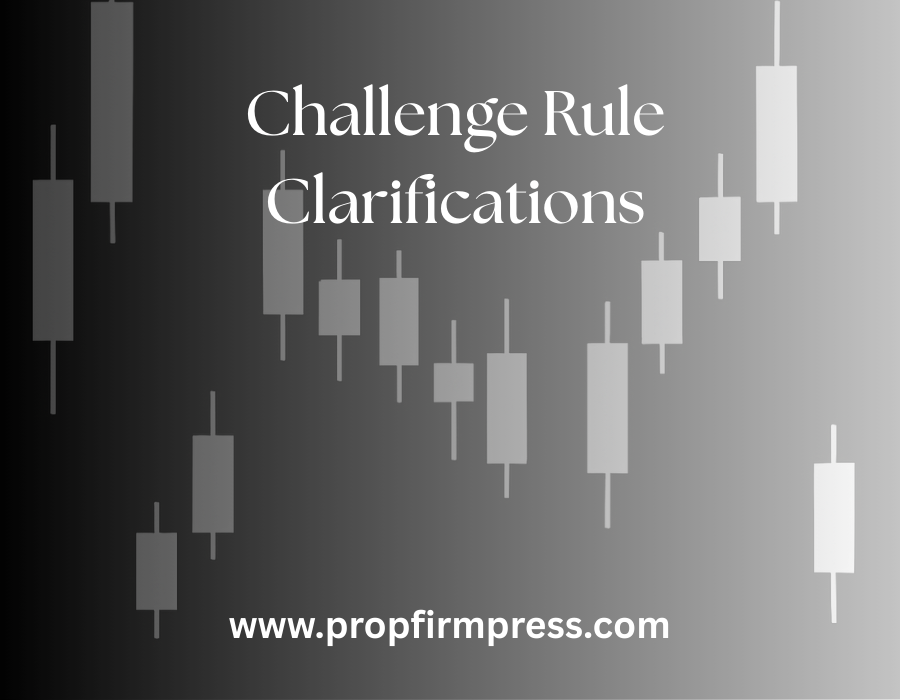Challenge Rule Clarifications
For traders engaging in prop firm challenges, understanding the exact rules is essential to progressing successfully through the stages. Challenge rules are often detailed and sometimes ambiguous, leading to confusion and unintentional failures. This article aims to clarify common points of contention and ensure traders approach challenges with confidence and clarity.
Maximum Daily Loss Limits
One of the most frequently misunderstood rules is the maximum daily loss. Typically, prop firms establish a daily loss limit to prevent significant drawdowns in a single trading session. This limit is often set as a percentage of the initial trading account balance. It is important to note that once this limit is breached, the challenge is automatically failed regardless of previous profits or account status. Understanding whether the daily loss limit resets each day or accumulates over multiple days is critical, as it impacts risk management strategies significantly. Traders should always refer to the specific firm’s guidelines to avoid misinterpretation.
Profit Target Requirements
Profit targets define the minimum net gains a trader must achieve to pass the challenge phase. These targets often vary depending on the firm and the account size offered. A common misconception is that the profit target needs to be reached within a set number of trading days, but some prop firms allow extended time frames as long as the target is met before the expiration date. Another aspect to clarify is whether the profit target is cumulative, meaning total profit after losses, or if gross profits apply. Clarifying these rules helps traders set realistic goals and avoid unnecessary pressure that could lead to poor decision-making.
Trade Volume and Minimum Number of Trades
Certain challenges require traders to execute a minimum number of trades or a specific volume of lots before advancing. This rule ensures that traders demonstrate consistent activity and are not attempting to pass the challenge with only a few successful trades. However, confusion arises when firms fail to state if these trades need to be closed or if open positions count toward the minimum. Additionally, the definition of a “trade” might vary – some consider opening and closing a position as one trade, while others count each separately. Getting these details right will prevent surprises at the end of the challenge period.
Allowed Instruments and Trading Hours
Many prop firm challenges restrict the types of instruments traders can use or limit trading to specific market hours. For example, some challenges allow only forex pairs or indices, while others may restrict trading to standard market hours to maintain fair conditions. Ignoring these constraints can lead to disqualification even if the profit target is met. Traders should review the rules carefully to understand which asset classes are permissible and any time restrictions, as trading outside these parameters often constitutes a direct violation.
Scaling Plans and Evaluation Periods
After successfully passing the initial challenge, traders often enter an evaluation or verification phase before receiving funded accounts. These stages may include scaling plans where profit targets and drawdown limits adjust dynamically based on account size. Understanding when and how these evaluation periods apply is crucial, especially since their rules may differ slightly from the initial challenge. Awareness of the transition between stages helps traders adjust risk management frameworks and anticipate changes in performance expectations.
Drawdown Rules and Recovery Factors
Drawdown limits are often a complex aspect of challenge rules. Some firms impose a maximum overall drawdown from the account’s peak equity, while others set a fixed drawdown from the starting balance. Additionally, not all drawdowns immediately end the challenge; many firms allow recovery from losses provided traders maintain a healthy equity curve by challenge completion. It is important to clarify how drawdowns are calculated, whether floating or static drawdowns apply, and if aggressive recovery trading is discouraged or penalized. This knowledge will frame risk-taking behavior during the challenge.
Position Sizing and Leverage Restrictions
Leverage and position sizing limitations are implemented to control risk. Some challenges specify maximum leverage levels or restrict lot sizes on individual trades. Misunderstanding these rules can result in invalid trades or immediate failure if limits are exceeded. Additionally, certain prop firms prevent averaging down or grid trading strategies to encourage disciplined trade management. Traders should confirm how these rules apply and ensure their trading style complies with all constraints to avoid costly rule breaches.
Use of Expert Advisors and Automated Systems
The acceptance of automated trading strategies or Expert Advisors (EAs) varies greatly between prop firms. Some challenges explicitly allow full automation, while others prohibit any form of algorithmic trading. Traders often overlook this critical rule, leading to disqualification when detected using forbidden automation. It is necessary to read the challenge terms thoroughly to know if EAs, copy trading, or signal services are permitted. Clarifying this upfront prevents time and financial loss associated with rule violations.
Reattempt and Refund Policies
When a challenge is failed, many traders wonder about the options for retrying. Each prop firm establishes its own conditions regarding re-attempts and potential refunds. Some allow unlimited attempts within a set period, sometimes at a discounted fee, while others restrict retries or require full payment again. Clarifying reattempt policies ensures traders understand their long-term commitments and can plan their trading journey accordingly without unexpected financial strain.
Trading success comes from discipline and review. Unlock your edge with the Trader’s Monthly PnL Tracker.
